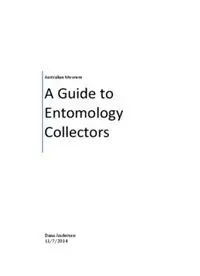Table Of ContentAustralian Museum
A Guide to
Entomology
Collectors
Dana Anderson
11/7/2014
Quick Guide to Collectors Labels – click on the
collectors name to be taken to their biography.
BROOKS, John G.
BICKEL, Daniel J.
BANCROFT,
Thomas L. BRITTON, David
R.
BULBERT, CARNABY, Keith
Matthew
CAMPBELL,
Thomas G. CASSIS, Gerasimos
A.
COURTNEY-
CHADWICK, HAINES, DAY, Barry J.
Clarence E. Lawrence M. DANIELS, Greg
DE KEYZER, Roger
DISNEY, Henry DOBSON,
John de Suffren Roderick DODD, Frederick
P.
DOOLAN, Dallas A. EASTWOOD,
Rodney G.
DU BOULAY, ELGNER,
Francis H. Hermann
GIBBONS, Charles
EVANS, John W.
ELLIOTT, Michael
G. ENGLISH,
Kathleen M.I.
GINN, Scott G.. GOLDFINCH, GOLLAN, John R.
Gilbert M. HANLON, T.M.S
1
HOLLOWAY,
LASSAU, Scott A.
Geoffrey A.
HARDY, George KENT, Deborah S.
H.H.
MCKEOWN, Keith
MCEVEY, Shane F.
MCALPINE, David
C.
K. MIDDLETON,
Bertram L.
MOSSE-
MOULDS, Maxell
ROBINSON, Leslie MULDER, Rudolph
S. MUSGRAVE,
H. H.
Anthony
PONDER, Winston
NICHOLSON, F.
POPE, Elizabeth
Alexander J.
C..
RENTZ, David C.F.
SCHUH, Randall T.
RODD, Norman W.
SKUSE, Frederick
ROBINSON, Vic J.. A.A.
SPENCE, Kenneth TATARNIC,
SMITHERS, K.. Nikolai
Courtenay N. SUNDHOLM, Allen
THEISCHINGER,
TONNOIR, André
TILLYARD, Robin TURAK, Eren
Günther
L.
J.
WATERHOUSE,
Gustavus A.
WARD, Melbourne WHITLEY, WILLIAMS,
GILBERT P.
Geoffrey A.
2
BANCROFT, Thomas L.
Dr Thomas Lane Bancroft was a medical naturalist who was born in Nottingham,
England in 1860, and arrived in Brisbane in 1864. He was educated at Edinburgh
University where he gained his M.B. in 1878 and a Ch.M. in 1883 with the bronze
medal for botany. In 1894 he moved to Deception Bay, where he did his best
work. He discovered that female mosquitos, thought to be short lived and
dependent on blood meals, would survive for weeks on bananas. In 1899, using
Culex fatigans mosquitos which he had reared and fed on a patient with filariasis,
he defined and illustrated each stage of the larval worm over a developmental
period of sixteen days. From 1905-06 he held temporary appointments with the
State Health Department investigating dengue fever, beriberi and the plague. He
correctly suspected but failed to prove that the Aedes aegypti was the carrier of
dengue fever. He freely provided material for fellow scientists which led to
recognition of many new species in freshwater algae, eucalypts, mosquitos, fruit-
flies, spiders, fish and snakes, many of which were named after him. He collected
around Australia, predominantly in Queensland.
3
BICKEL, Daniel J.
Dr Daniel (Dan) John Bickel has a Ph.D. in Entomology and is a Senior Research
Scientist at the Australian Museum. He has an interest in the systematics and
ecology of Diptera and has research interest in empidoid Diptera (Empididae and
Dolichopodidae). He is currently working on a 3 year ARC Discovery Grant to
investigate the source and the inclusions of insect and plants that are found in
amber washed up on the beaches of the Northern Cape York Peninsula. He
collected around Australia from 1980 onwards.
4
BRITTON, David R.
Dr David (Dave) Britton currently works at the Australian Museum as Branch
Head of Natural Sciences & Biodiversity Conservation. He has an extensive
background in entomology with research interests in insect conservation, pest
management of insects in field crops, nutritional and behavioural ecology and
the taxonomy of moths. Dave has been involved with various projects such as the
BushBlitz program, Council of Heads of Faunal Collections, Council of Heads of
Entomological Collections, Australian Faunal Directory and the Atlas of Living
Australia. He collected around Australia during the 2000’s.
5
BROOKS, John G.
John George Brooks was born in Townsville. He moved to Geraldton, Western
Australia and it was here where his interest in Coleoptera developed. He
graduated as a dental surgeon from the University of Queensland. During 1940-
1946 he served with the Royal Australian Dental Corps in Australia and New
Guinea and upon his return to Australia he took up a practice. He was one of the
most respected and best known entomologists and his Coleoptera collection was
presented to the Australian National Insect Collection (ANIC). He collected
around Australia, predominantly in Queensland.
6
BULBERT, Matthew
Matthew Bulbert worked at the Australian Museum from 2000-09. He is a
behavioural ecologist whose interests are with rare fauna and flora, particularly
invertebrates and looking at the role of natural selection in the evolution of
animal communication. He collected around Australia, predominantly in Western
Australia during the 2000’s.
7
CAMPBELL, Thomas G.
Thomas Graham Campbell was an Australian entomologist. He was Assistant
Entomologist at the Australian Museum from 1920-1928. He was the
Entomological Assistant to the Commonwealth Scientific and Industrial Research
(CSIR) in Canberra and later became Research Officer in the Division of
Entomology at the Commonwealth Scientific and Industrial Research
Organisation (CSIRO). He undertook two entomological surveys of the Cocos
(Keeling) Islands, the first carried out on behalf of the Department of Civil
Aviation in 1952, and the second for the CSIRO Division of Entomology in 1964.
He also surveyed the insects of Christmas Island in 1964. He collected a variety
of insects, but generally focused on Diptera, Coleoptera and Hemiptera in
Queensland, New South Wales and northern Western Australia from the early
1920’s to the late 1960’s.
8
CARNABY, Keith
Keith Carnaby was a Western Australian entomologist and a Coleoptera
collector, who specialised in Buprestidae. His collection of Coleoptera and
Lepidoptera is considered only second to that of the British Museum. His
collection of North American Jewel Beetles was donated to the Australian
National Insect Collection (ANIC) in 1988 and the Australian specimens were
donated in 1994. He collected predominantly in Western Australia from 1923
until the 1980’s.
9

